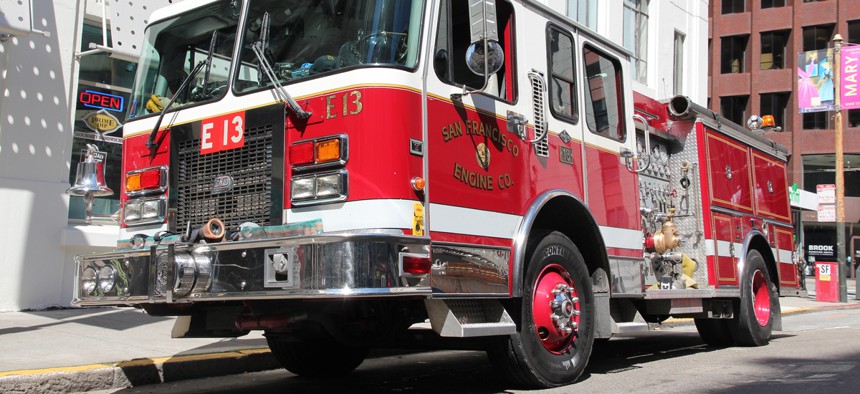Firefighters Push for Inclusion in First Phase of Covid-19 Vaccines

Tupungato/Shutterstock
States are finalizing their vaccine distribution plans, which will determine which critical workers and high-risk people are first in line for a coronavirus vaccination.
As states establish priorities for how they will distribute the initial round of Covid-19 vaccines, firefighters are pushing to be included in the first wave of recipients.
The majority of calls that firefighters and EMTs respond to are medical in nature, and many have been exposed to Covid while on duty, according to the International Association of Fire Fighters. The potential for firefighters’ exposure, coupled with the role that fire departments could play in the administration of a vaccine, the IAFF is asking state governors to include firefighters in the same vaccine distribution tier as high-risk health care workers.
“Adequately vaccinating firefighters and emergency medical responders will also allow such personnel to continue serving their communities during this medical crisis,” the IAFF wrote in a letter to the National Governors Association.
Exactly when the vaccine will be available isn’t yet clear, but manufacturer Pfizer has already requested emergency use authorization and Moderna is expected to soon. That means if the Food and Drug Administration moves forward with approval as many expect, distribution of vaccines could begin to certain groups of people as early as December.
While review of the vaccine candidates is happening at the federal level, states are rapidly finalizing plans that outline who will be first in line. Initially, it is expected that 40 million doses will be available by the end of the year, but because each vaccine requires two doses, that only covers 20 million people. On Tuesday, officials said front-line health care workers, like those in hospitals, are expected to get the first 6.4 million doses of Pfizer’s vaccine.
Nationally, about 65% of calls that fire departments respond to are medical calls, according to the National Fire Protection Association. Those interactions put firefighters at greater risk of exposure than if they were fighting fires alone, said Doug Stern, the director of media relations at the IAFF.
“We know these firefighters are going out and dealing with Covid-positive people and a lot of times they are not finding out until well into the call,” Stern said.
Earlier this year, the National Academies of Science, Engineering, and Medicine recommended that firefighters and emergency medical services personnel be placed in the highest priority tier for receiving a Covid-19 vaccine. And some see a secondary benefit to this inclusion among the first wave of vaccinations—allowing those workers to assist in the distribution and vaccination of others.
“Fire and EMS personnel in many cities already are facilitating COVID-19 testing,” wrote the International Fire Chiefs Association in a letter backing the national academies recommendation. “America’s fire and emergency service could assist in this mission by relying on their pre-existing, strategically-located positions as well as serving as a recognized and trusted source of health information in many communities.”
Several fire departments in Massachusetts say they already trained paramedics how to administer flu shots as part of a prior pandemic preparedness exercise, and expect to utilize that training to distribute Covid-19 vaccines.
States were required to submit their draft vaccine distribution plans to the Centers for Disease Control and Prevention in October. Many remain a work in progress and are incorporating feedback. While the federal government is expected to make recommendations for priority vaccinations, governors will be in charge of prioritized distribution within their own states, Health and Human Services Secretary Alex Azar said this week.
The state-level plans identify priority populations for the vaccine, relying heavily on guidance from the federal government to define who to include in those priority populations. But state plans vary in where they have ranked firefighters and other first responders, Stern said.
New Hampshire’s plan includes first responders such as police, firefighters and EMTs in the first tier of vaccine distribution. But North Carolina’s plan draws a distinction between paramedics and EMTs, who are included in the first wave of vaccines, and firefighters and police officers, who are included in the second wave.
“Health care personnel at high risk of exposure were prioritized first,” wrote Catie Armstrong, a spokesperson for North Carolina’s Department of Health and Human Services, in an email response to questions about the plan. “First responders that have a higher likelihood of close exposure to and would be providing health care to people with Covid-19 (e.g., EMTs) were prioritized with other health care personnel.”
Throughout the pandemic, Covid-19 outbreaks have ricocheted through fire departments and at times sidelined large numbers of emergency responders. A third of Springfield, Illinois firefighters were quarantining earlier this month, requiring the department to put two engine trucks out of service. Last weekend, a fire captain and paramedic from the Kansas City Fire Department both died from Covid-19. More than 70 agency employees are currently infected with the virus.
The IAFF counts at least 19 firefighters who have died from Covid-19 and more than 17,000 who have been required to quarantine as the result of an exposure. Through September, EMS1 identified at least 36 EMS personnel who had died from Covid-19.
“Absent adequate vaccination, responders will continue to be subject to lengthy quarantines when they are exposed to Covid-19 positive individuals, imposing significant costs on local governments as they backfill positions or operate understaffed, increasing response times and negatively impacting public safety,” the IAFF wrote.
Andrea Noble is a staff correspondent with Route Fifty.
NEXT STORY: States Join Pilot to Investigate Cases of Missing and Murdered Indigenous People





